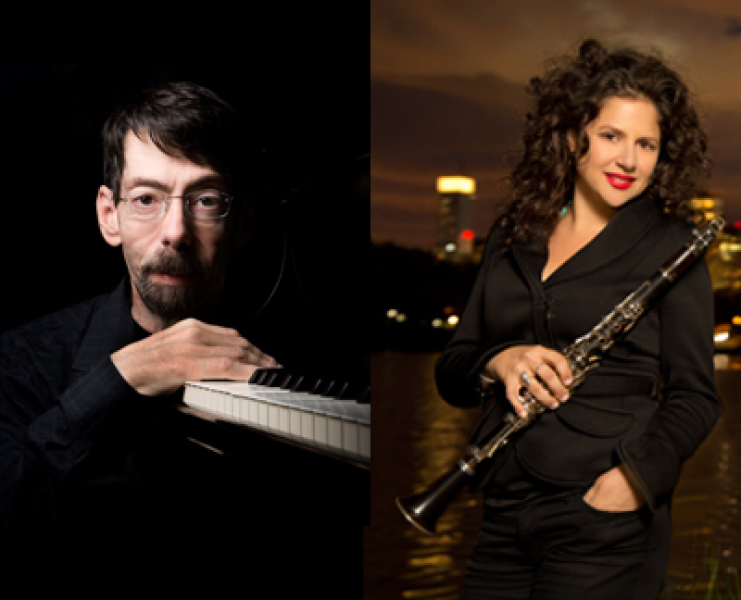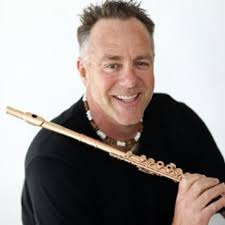A Subtle Genius – Fred Hersch & Anat Cohen

Fred Hersch and Anat Cohen [photos used with permission of the La Jolla Athenaeum]
Opening in an ECM-like mood with Hersch’s own “A Lark (for Kenny Wheeler),” he set a pastoral atmosphere with a harmonically Impressionistic introduction. The opening melody was spun in unison with Cohen, who played clarinet for the entire show. She experienced some intonation challenges throughout the evening, mostly due to our lovely “June Gloom” weather pattern, with its less than salubrious effect upon reeds and wind instruments. Bravely soldiering on, she progressively forged a stunning solo that began almost imperceptibly. By fusing Hersch’s original melody directly into her improvisation, it was nearly impossible to tell where “Hersch” ended and “Cohen” began. This mutual subsuming set the pattern for the entire evening.
Cohen has to be counted as one of the three leading contemporary clarinetists active in jazz. Unlike the other two, she does not carry the burden of imposing, classical strictures concerning tone production. The result is a slightly gritty, rougher sound that is profoundly expressive and capable of a more hot-blooded emotional outpouring than is usually the case with the normally tepid instrument. Her clean, almost stark, vibrato-less approach has rendered international success, as she is a perennial jazz poll winner.
“Child Song,” another Hersch original, followed. Dedicated to the late bassist Charlie Haden, with whom the tune was recorded, and redolent of Keith Jarrett’s “Scandinavian Quartet,” its apt title communicates the impression of a child’s sense of wonder through its use of a simple and very lyrical melody, accompanied by straightforward chordal sequences, followed by an indeterminate “free” section. During Cohen’s opening statement of the melody, Hersch did some fascinating things. At one point, if one were deeply listening, he would have heard a harmonic misstep, a false note. Yet, it did not sound remotely like a mistake because of the harmonic progress that followed. This rare ability to incorporate an unintended result into artful recovery has been imputed to only the very greatest of jazz musicians, most notably Miles Davis and Charlie Parker. At the end of the extended period of free improvisation, the return to the opening melody was seamless.
Antonio Carlos Jobim’s “O Grande Amor” provided Cohen with an opportunity to display her impressive breath control. Long, serpentine phrases flowed from her clarinet, yet rhythm became the star of this particular show. Each of the musicians has a deeply rooted and unshakeable rhythmic sense, so the groove they created allowed for unorthodox time subdivisions with many hemiolas, where regular accents are moved from one part of a two measure pattern to another. They sustained this playful rhythmic game, returning to it time and time again throughout the evening, but never once letting the actual tempo move. Finally, when the expected downbeat came back at the top of the tune’s form, they nailed it with sublime precision that took my breath away.
We were treated next to a Cohen original entitled “Purple Piece.” The song has the rather unusual quality of being in 3/4 time, typical of waltzes, but is not the least bit reminiscent of one. Unusual, because 99.9% of triple time tunes in jazz resort to a waltz feel, which is usually boring, predictable and unimaginative. “Purple Piece,” however, was none of those things. Hersch came across a little stiffly in the first two choruses, perhaps because the piece was a newer one to his repertoire. Really grasping the form after the second chorus, he stopped reading the chart and spun gorgeous and unexpected chordal reworkings that allowed the clarinetist to ramble freely. Her sound was incredibly expressive, and the fullness and profundity of her expression brought to mind the John Coltrane of the great Quartet era. When Cohen played on slower tunes, she drew out existential feelings that challenged her listeners to face their own mortality.
Not surprisingly, the duo then dug into the riches of the jazz repertoire, and up jumped “Isfahan” by Billy Strayhorn. With its rich harmonic writing, distinctive melody and relative obscurity, Cohen and Hersch were free to let their dry, subtle humor run rampant. To this end, after presenting a completely restructured formatting of the chords, Hersch went on a stride piano tear. It was as if Monk and Eubie Blake melded together into one, post-modern pianist.
One of the most arresting attributes of the evening was that regardless of whether they were doing the head, improvising over the chord changes or playing accompanying roles, a vital, strong sense of wordless narrative presided. Everything played made sense in a natural, totally abstract way, allowing the audience to visit their own private spaces, unencumbered with expectation or banal reference.
The medium tempo swing of “Isfahan” was followed by the evening’s second ballad, Hersch’s “Peacocks.” Inspired by the influence of the great Jimmy Rowles, whom the younger pianist listened to incessantly at Bradley’s in Greenwich Village, the ballad’s slower tempo gave Cohen another opportunity to channel her inner Coltrane.
Another Brazilian tune, “Doce de Coco,” concluded the program. Again, the end of the head ran seamlessly into the improvised solo. Unless the listener was rather obsessively paying attention to it, the new chorus would not have been recognized. Hersch virtuosically fractured the original chords by creating a fascinating and ever changing two part counterpoint, while Cohen creatively remained within the conversation and contributed her own unique and sensitive take on the changes.
This concert presented two distinctive and accomplished artists. Their overwhelming mastery was on display with every gesture, and the freshness and soulfulness of expression was an honor to witness.

Yochanan Sebastian Winston, Ph.D. has performed throughout the United States, Europe and Latin America. His repertoire spans classical, jazz, klezmer, new age, contemporary, rock & roll and pop and is very active as a composer. Dr. Winston holds a Ph.D. from the UCSD, a Diplôme from the Conservatoire National de Region de Boulogne-Billancourt (France), and a Master’s and Bachelor’s of Music from the Manhattan School of Music in New York City.
